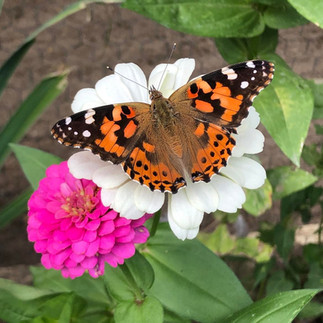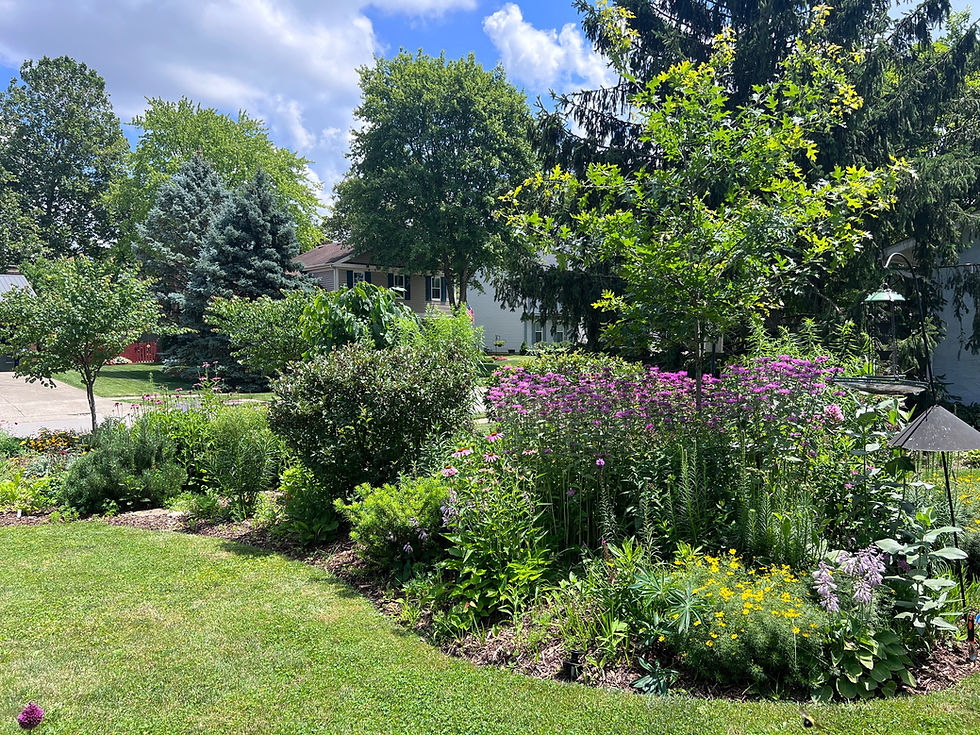How to Attract Butterflies to Your Yard
- Cathy Tiffany

- Jun 10, 2024
- 4 min read
Fall and Spring are excellent times to make plans for a butterfly garden...but as of today, we're in full blown summer, so where do you go from there?
Summer is a more expensive time to create a butterfly garden because now you'll typically have to buy plants and not start from seed. You're going to have to baby your plants a little more because the weather is already warm. But, the bright side is that by starting with existing plants, you'll get immediate gratification and the fruits of your labor will happen NOW!
All these pics are taken in our suburban yard. We don't have "property", we live on a typical cul-de-sac. The point is, you don't need a lot of space to enjoy your own butterfly (pollinator) garden!
You can literally create one on a small balcony, your patio, porch or yard. Two pots of the right plants will do the trick, or a spot 20 ft².
What are the "right plants" and how do you get started? This is actually one of the topics that compelled me to start my blog and podcast (Backyard Columbus, wherever you get your podcasts). People know they don't see many butterflies anymore, but they don't know why.
The "why" is actually pretty simple: pollinators - butterflies, moths, flies, bees, etc, need sources of food, like we all do. Butterflies (and moths) need nectar. Nectar is found in flowers - but the right kind of flowers.
In our tidy and designed suburbs, hundreds of acres are stripped, homes built and then "structured nature" gets put in its place. So, more than likely, your yard came stocked with a tree, some evergreen bushes and daylilies. In the case of butterfly food, not one of those plants feed a butterfly. Obviously the bush and tree don't, but what about the flowers on the daylily? This is almost the entire reason you don't see butterflies anymore. No one has nectar sources. A daylily is more often than not a hybridized flower, exotic or lab-improved and almost void of nectar. Allow me to get specific and it'll be quick and easy:
Plant native plants. Most folks don't plant native plants - but that's changing. Native plants (plants that have naturally occurred for eons in the area you live) provide everything our local butterflies need. No lab meddling, just natural.
Verify the flower you want to plant actually has nectar. I just learned this a few years ago: not all flowers are created equal. In our modern era and scientific achievements, we can create flowers in every color aside from their natural state. Here's where the problem comes in: those "hybridized" flowers are often (not exclusively) sterile. That means they don't produce nectar or it's of such a poor quality that it's like junk food. This is where point #1 comes in: plant native. Now look, if you see a flower that rocks your world, then by all means buy it, just for the smile it puts on your face...and buy the native one so you'll be sure to attract the butterflies you wish to see. Without sources of good quality food, then you won't see butterflies. Click HERE for ideas and if you need help, ask you local nursery to help you pick a good nectar producing flower.
Plant a host plant. Host plants are plants that an organism lives on and lives off of. Each butterfly and moth has a host plant, or a family of host plants. A PERFECT example of this is the iconic monarch butterfly. The host plant for the monarch is milkweed. Despite their name, milkweeds are wildflowers. There are over 73 species of milkweed native to the United States, and about 30 species are used regularly by monarchs. Most species grow in specific regions of the country. If you want to grow milkweed, plant milkweed native to your region. Here's the way this works: a female monarch comes along, lays its eggs on milkweed. The resulting caterpillars need the milkweed leaves to eat to keep its toxicity and ward off predators. Anyhoo, that's the only thing monarch caterpillars can eat. That caterpillar grows, makes a chrysalis, the butterfly emerges... then we're back to points 1 & 2!
I feel like I could talk about this subject all day, so I'll summarize by closing with this:
Overwhelmingly, sunny spots (6+ hours of sunlight a day) do the best for butterfly gardens, but you can get by with less. Just buy the right plants for the sunlight you get.
Start small - even 2 pots will do. Fill one pot with zinnias (nectar sources) and plop a milkweed or fennel (the host plant for the Black Swallowtail) or any other host plant you Google and you'll be amazed at what butterflies find your space!
Stick with native plants to your area and then a few US plants (zinnias, cosmos, marigolds, etc) and you'll be enjoying butterflies in no time!
Happy Summer!

















Comments